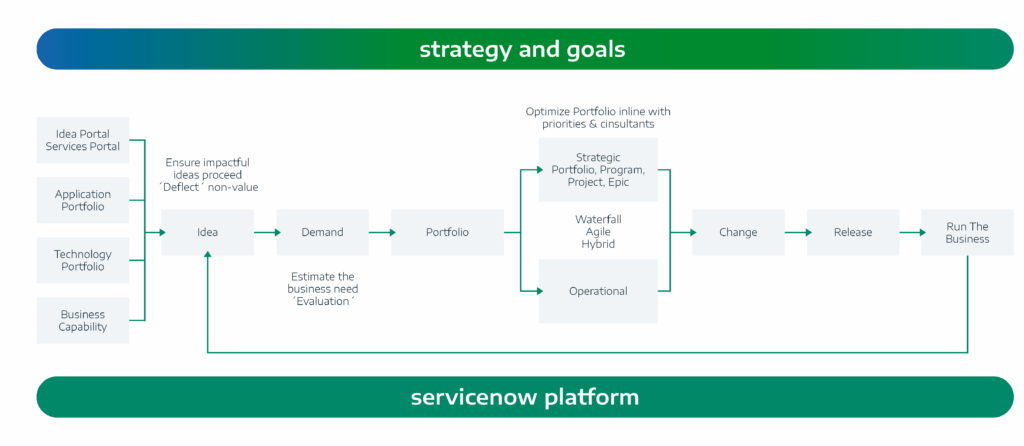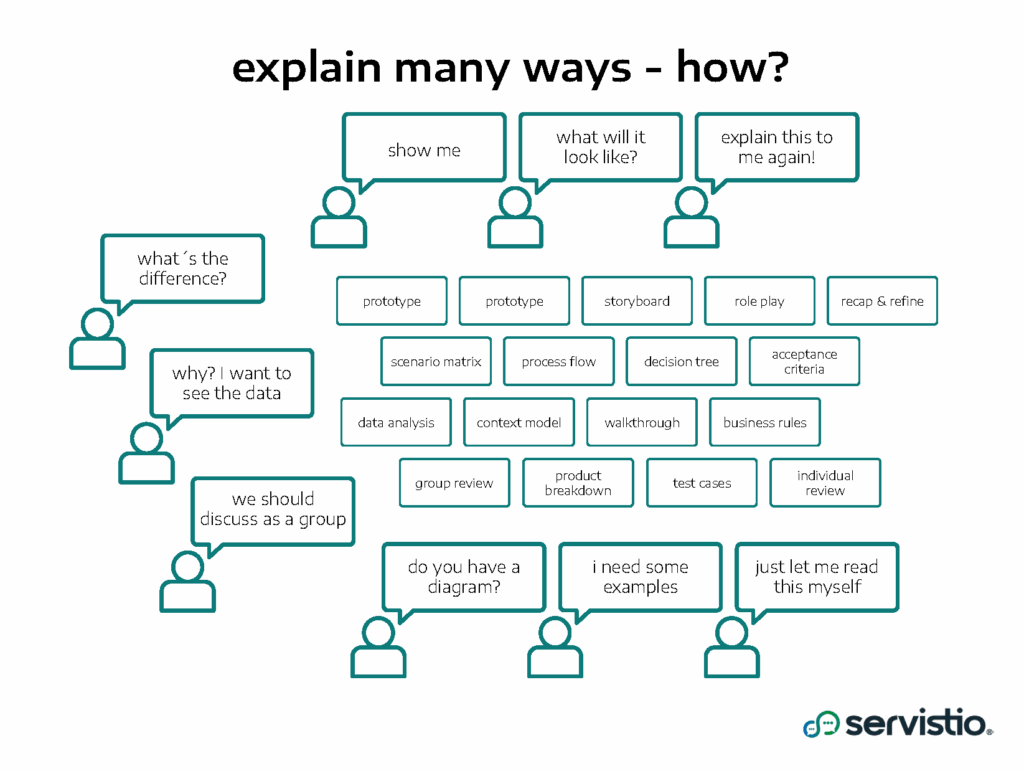How can business analysts effectively capture business requirements for ServiceNow projects?
ServiceNow offers companies an effective lever for optimizing business processes and improving service provision. In order to fully exploit the platform’s potential, business requirements must be captured in a comprehensive and structured manner. Business analysts (BAs) play a key role here: they mediate between the stakeholders and the technical team and translate business requirements into clearly defined, technically feasible processes.
This practical guide presents proven methods and best practices that BAs should use to consistently align a ServiceNow implementation with business objectives. This ensures that the project is closely aligned with business objectives and delivers measurable added value.

Involve stakeholders proactively and continuously
The basis for effective requirements gathering is the active and continuous involvement of all stakeholders. Stakeholders include everyone with an interest in the project, from department heads to end users. Their insights are crucial in determining the scope and objectives of the project.
Techniques for effective stakeholder engagement
| 1. | Interviews and workshops | Conduct one-on-one meetings and group workshops to understand stakeholders’ problems, goals and needs. Workshops are ideal for joint brainstorming and coordination. |
| 2. | Surveys and questionnaires | Use surveys to gather targeted feedback from larger groups, especially end users, and ensure that all voices are considered. |
| 3. | Stakeholder Mapping | Create a map to categorize stakeholders by influence and interest so you can prioritize their feedback and focus on the most important voices. |
Important considerations
Early commitment: Involve stakeholders as early as possible to ensure that their needs are taken into account from the start of the project.
Continuous interaction: Keep communication open throughout the project so that you can respond to changing requirements and feedback.
Understanding current processes and systems in depth
Before defining new requirements, you should gain a comprehensive overview of the existing processes and systems that are affected by ServiceNow. This knowledge will help you to identify opportunities for improvement and ensure alignment with business objectives.
Techniques for process understanding
| 1. | Process Mapping | Work with stakeholders to create visual representations of existing workflows and systems. This makes it easier to identify inefficiencies and opportunities for automation. Tools such as Lucid Chart or Microsoft Visio can help with the creation of diagrams and serve as project references. |
| 2. | Gap analysis | Compare current processes with desired outcomes to identify gaps that should be closed by implementing ServiceNow, ensuring alignment with strategic goals. |
| 3. | SWOT analysis | Analyze the strengths, weaknesses, opportunities and risks of the current processes to determine the most important focal points for the ServiceNow project. |
Important considerations
Document current problems: When interacting with stakeholders, focus on capturing problems with the current system. This will help you to formulate the requirements for the new solution.
Ensure alignment: Use a gap analysis to ensure that the new system closes the identified gaps and aligns with the organization’s long-term goals.
Develop detailed scenarios and use cases
Scenarios and use cases are powerful tools to visualize how the new system will work and ensure that all necessary requirements are captured. They provide a clear picture of system interactions and help stakeholders understand the impact of their requirements.
Techniques for developing scenarios and use cases
| 1. | User stories | Write simple user stories in the following format: “As a [user], I want [action] so that [benefit].” This breaks down complex requirements and ensures that the system meets the actual requirements. |
| 2. | Use Case Diagrams | Create visual diagrams to show how users (actors) interact with the system, helping to map all possible interactions and system functions. |
| 3. | Mockups and prototypes | Develop mockups or prototypes to provide stakeholders with a visual, tangible representation of the system, making it easier to gather feedback and refine requirements. |
Important considerations
Simplify complex requirements: Use user stories and use case diagrams to break down complex requirements into easy-to-understand components.
Ensure comprehensive coverage: Use cases help to ensure that all possible interactions are taken into account, thereby avoiding gaps in the system’s functionality.

Use the integrated tools from ServiceNow
ServiceNow offers several tools to simplify and optimize requirements capture.
Important ServiceNow tools for requirements capture
| 1. | Agile development | Manage requirements as user stories and tasks so that everything is organized and aligned with project timelines. |
| 2. | Knowledge Base | Save and share requirements and updates for transparency and easy access. |
| 3. | Workflow Design | Visualize and organize workflows to ensure processes are aligned with project goals. |
| 4. | ServiceNow Configuration Management Database (CMDB) | Understand the relationships and dependencies between components to ensure smooth system integration into the existing infrastructure. |
Important considerations
Organize and track requirements: Use agile development tools in ServiceNow to organize requirements and easily track progress.
Visualize and coordinate workflows: The Workflow Designer helps to map processes to ensure alignment with the company’s objectives.
Kontinuierliche Validierung und Feedback sicherstellen
Die Erfassung von Anforderungen ist ein fortlaufender Prozess, der regelmäßig überprüft werden muss, um mit den Unternehmenszielen im Einklang zu bleiben.
Techniken zur kontinuierlichen Validierung
| 1. | Regelmäßige Überprüfungssitzungen | Halten Sie regelmäßig Besprechungen mit den Beteiligten ab, um die Anforderungen zu überprüfen und bei Bedarf anzupassen, damit sie mit den Projektzielen übereinstimmen. |
| 2. | Pilotversuche | Führen Sie vor der vollständigen Einführung Pilotversuche mit einer ausgewählten Gruppe von Benutzern durch, um Feedback aus der Praxis zu sammeln, und nehmen Sie gegebenenfalls Anpassungen vor. |
| 3. | Feedback Loops | Schaffen Sie kontinuierliche Feedback-Schleifen, um auch nach Festlegung der ursprünglichen Anforderungen die Beiträge der Stakeholder zu erfassen und sicherzustellen, dass Änderungen oder neue Anforderungen umgehend berücksichtigt werden. |
Wichtige Überlegungen
Ausrichtung beibehalten: Regelmäßige Überprüfungen stellen sicher, dass die Anforderungen mit den Geschäftszielen übereinstimmen.
Schnell iterieren: Nutzen Sie Pilotversuche und Feedback-Schleifen, um schnelle Anpassungen vorzunehmen und sicherzustellen, dass das System den Anforderungen der Benutzer entspricht.
Dokumentieren Sie alles gründlich und gewährleisten Sie die Rückverfolgbarkeit.
Eine ordnungsgemäße Dokumentation und Rückverfolgbarkeit sind unerlässlich, um den Überblick über die Anforderungen zu behalten und sicherzustellen, dass während des Implementierungsprozesses nichts übersehen wird.
Techniken für eine effektive Dokumentation und Rückverfolgbarkeit
| 1. | Detaillierte Anforderungsdokumentation | Erstellen Sie umfassende Dokumente, die Anforderungen, Annahmen, Einschränkungen und Abhängigkeiten abdecken. Diese dienen als Leitfaden für Ihr Projekt- und Entwicklungsteam. |
| 2. | Rückverfolgbarkeitsmatrix | Verwenden Sie eine Matrix, um jede Anforderung mit den entsprechenden Phasen der Konzeption, Entwicklung und Prüfung zu verknüpfen. So stellen Sie sicher, dass alle Anforderungen erfüllt werden, und können Lücken leichter erkennen. |
| 3. | Versionskontrolle | Verfolgen Sie Änderungen an Anforderungen im Laufe der Zeit mit einer Versionskontrolle, um eine klare Dokumentation zu gewährleisten und Scope Creep zu vermeiden. |
Wichtige Überlegungen
Führen Sie sorgfältige Aufzeichnungen: Eine detaillierte Dokumentation stellt sicher, dass alle Anforderungen erfasst werden und das Projekt planmäßig verläuft.
Vollständigkeit sicherstellen: Eine Rückverfolgbarkeitsmatrix hilft sicherzustellen, dass alle Anforderungen berücksichtigt werden und keine Lücken bei der Umsetzung entstehen.
Schlussfolgerung
Die Erfassung der Geschäftsanforderungen für ein ServiceNow-Projekt ist herausfordernd und gleichzeitig von entscheidender Bedeutung. Sie erfordert eine sorgfältige Planung, die kontinuierliche Einbindung der Stakeholder und ein solides Verständnis der Prozesse im Unternehmen. Klare und genau definierte Anforderungen sind der Schlüssel zum Erfolg eines ServiceNow-Projekts. Mit diesen Strategien legen Sie von Anfang an den Grundstein für den Erfolg Ihres Projekts.
